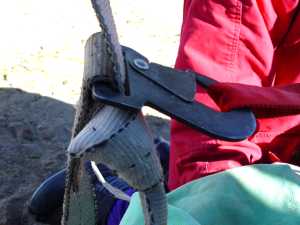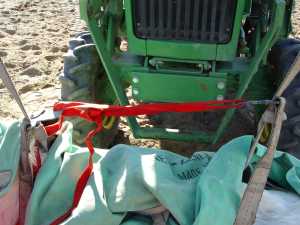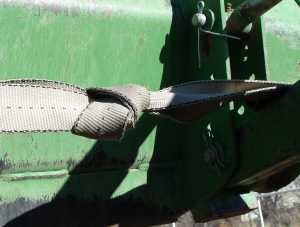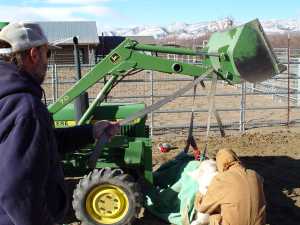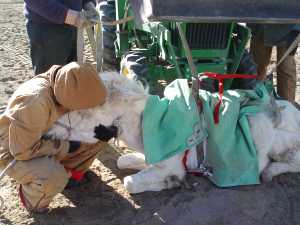Emergency ImprovisationsFashioning an Emergency Quick Sling |
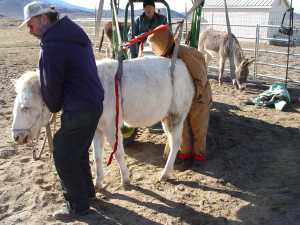
|
© 2004, Willis & Sharon Lamm
|
First we removed the ratchets from the nylon straps. We passed each strap under Bill and back through the narrow slot at the base of the strap hook. By tying an overhand knot in the strap below the hook, we could prevent the loops from tightening up on Bill.
The overhand knots could be easily adjusted so that the loops didn't get too tight, nor so large that Bill could slip through. |
Close-up of the strap and hook
|
|
In this situation we had planned to assist Bill to his feet using a bucket loader. We tied the straps across the bucket arms in order to prevent him from spinning once raised.
Since the arms were farther apart than our lift points, we tied the strap hooks together with some belting to adjust the lift width. (Rope or bailing twine could also serve this purpose.) |
The red webbing provides width adjustment
|
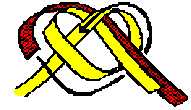 Since Bill was fairly light we were able to join the two straps using a flat knot or overhand follow through knot. (One strap is tied in an overhand knot and the other strap is passed through the knot from the opposite direction, following the first strap exactly. The end knot is actually a strong "double" overhand knot that can be easily loosened and adjusted.)
Since Bill was fairly light we were able to join the two straps using a flat knot or overhand follow through knot. (One strap is tied in an overhand knot and the other strap is passed through the knot from the opposite direction, following the first strap exactly. The end knot is actually a strong "double" overhand knot that can be easily loosened and adjusted.)
Note: When using a rope instead of webbing you should use a figure eight follow through knot, illustrated here. |
The flat knot
|
|
By taking up one of the ends from the flat knot we could make sure that the sling stayed centered when we started to lift.
(One end hung off each side of the loader lift arms.) |
Holding on to one of the ends.
|
|
Now we were ready to lift. We checked Bill and he still wanted to try to stand.
Since he was a relatively small animal we opted to remove the blanket. The extra padding wasn't needed and the bulk would make the process complicated. With a larger animal we would have likely padded the straps. We double checked the rigging and were ready to go. |
Final check
|
Continue to Part TwoPress Back to return to the page which brought you hereReturn to KBR Quick Tips Index PageReturn to KBR Horse Health SectionGo to KBR Safety SectionGo To
|


